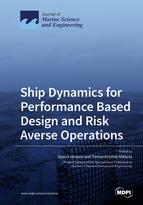Ship Dynamics for Performance Based Design and Risk Averse Operations
A special issue of Journal of Marine Science and Engineering (ISSN 2077-1312).
Deadline for manuscript submissions: closed (30 April 2020) | Viewed by 39399
Special Issue Editors
Interests: wave loads; ship dynamics; ship safety in design and operations; emerging technologies; risk management; sustainability
Special Issues, Collections and Topics in MDPI journals
Special Issue Information
Dear Colleagues,
The concept of ship dynamics has a very wide meaning, embracing the fundamentals of both deterministic and performance-based methods with ship safety. As such, the subject is of paramount importance for its wide implications in the design and operation of ships and floating offshore installations. Contemporary developments in this specific field tend to be collected and thoroughly debated especially considering uncertainties associated with multi-physics modeling and simulation as well as the emergence of modern technologies. With the aim of analyzing the current status and possible future perspectives of research in the field of ship dynamics and safety, in this Special Issue we invite high-value original research publications in the following consolidated research topics and emerging subjects:
- Wave loads and dynamic response with emphasis on hydroelastic methods, nonlinear hydrodynamics, and CFD methods
- Marine cybernetics with focus on motion suppression of ships and speed boats, navigation monitoring unified maneuvring/seakeeping, and control methods with a focus on operational performance
- Validation methods by model tests and full-scale measurements using state of the art methods and monitoring equipment (e.g., design of experiments, sensors, radar systems, etc.)
- Combined strength and stability with a focus on damaged conditions and the influence of crashworthiness. Papers that promote emergency response methods and future SOLAS requirements are especially welcome.
- Intact stability and resonance phenomena (e.g., parametric roll, broaching) with a focus on the use of nonlinear methods (bifurcation and chaos) within the context of future IMO standards.
- Risk management methods for the assurance of safety in ship design and operations
- The role of emerging technologies for ship performance monitoring (machine learning, artificial intelligence, big data, digital twins, etc.)
Prof. Dr. Spyros Hirdaris
Dr. Tommi Kristian MIKKOLA
Guest Editors
Manuscript Submission Information
Manuscripts should be submitted online at www.mdpi.com by registering and logging in to this website. Once you are registered, click here to go to the submission form. Manuscripts can be submitted until the deadline. All submissions that pass pre-check are peer-reviewed. Accepted papers will be published continuously in the journal (as soon as accepted) and will be listed together on the special issue website. Research articles, review articles as well as short communications are invited. For planned papers, a title and short abstract (about 100 words) can be sent to the Editorial Office for announcement on this website.
Submitted manuscripts should not have been published previously, nor be under consideration for publication elsewhere (except conference proceedings papers). All manuscripts are thoroughly refereed through a single-blind peer-review process. A guide for authors and other relevant information for submission of manuscripts is available on the Instructions for Authors page. Journal of Marine Science and Engineering is an international peer-reviewed open access monthly journal published by MDPI.
Please visit the Instructions for Authors page before submitting a manuscript. The Article Processing Charge (APC) for publication in this open access journal is 2600 CHF (Swiss Francs). Submitted papers should be well formatted and use good English. Authors may use MDPI's English editing service prior to publication or during author revisions.
Keywords
- Flexible fluid–structure interactions
- Marine hydrodynamics
- Model experiments
- Dynamic response
- Full-scale measurements
- Ship maneuvring
- Ship stability
- Wave loads
- Structural crashworthiness
- Machine learning, artificial intelligence, sensors, big data
- Ship safety in design and operations
- Risk management







